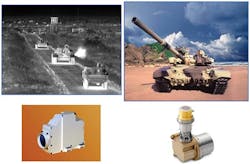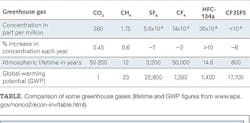Photonics Products: MWIR and LWIR Detectors: QWIPs capture LWIR images at low cost
Optical imaging systems that operate in the thermal infrared region, which includes midwave infrared (MWIR) and long-wave infrared (LWIR), can capture images of objects solely by imaging the heat they emit. In particular, the capture of LWIR radiation allows the imaging of objects (including living objects) that are in the room-temperature range. In addition, because the thermal infrared region includes molecular absorption lines, MWIR and LWIR detectors can be used to detect the presence of trace amounts of some important chemical species.
While one of the most widely used types of thermal detectors is based on mercury cadmium telluride (HgCdTe, or MCT), another type of detector, called the quantum-well infrared photodetector (QWIP), competes against the MCT detector for certain uses. The QWIP focal-plane array (FPA), which has been commercially available for more than a decade, has a number of semiconductor quantum wells (typically based on gallium arsenide) separated by barriers, allowing the detectors to capture photons via intersubband transitions (in a way, they can be considered a light-absorbing analogue of quantum cascade lasers, which emit light via intersubband transitions).
Mature III-V technology
"QWIP detectors constitute a viable option in the LWIR portion of the spectrum," says Axel Reisinger, chief technical officer and cofounder of QmagiQ (Nashua, NH). "Being based on very mature III-V semiconductors, they offer much higher manufacturing yields and operational stability—and therefore cost-than the incumbent HgCdTe devices. On the downside, they suffer from inherently much lower quantum efficiencies, which limits their use to applications than can tolerate long integration times (somewhat similar to a "slow" photographic film requiring long exposures in order to collect a sufficient number of photons). That characteristic makes them unsuitable to detect/track fast moving targets or rapidly changing scenes. That said, QWIPs are perfectly adequate—indeed can be superior—for any application requiring frame rates no higher than 30 or 60 Hz."
In addition to persistent-surveillance applications compatible with the restrictions described by Reisinger, QWIP-based imagers are used to detect sulfur hexafluoride (SF6) gas leaks from electrical power-utility components such as circuit breakers and high-voltage electrical transformers. "The power-utility industry uses QWIP-based cameras that incorporate a cold narrowband spectral filter centered on the absorption line of the SF6 gas (at a wavelength of about 10.6 μm) to remotely detect and locate SF6 clouds, which manifest themselves as black plumes," he notes.
"Power utilities are anxious to detect SF6 leaks and pinpoint their sources before catastrophic hardware failures result in disruptive service interruptions and expensive, time-consuming repairs," says Reisinger "In addition, SF6 is one of the most potent greenhouse gases known-its global warming potential (GWP) is more than 20,000 times greater than that of carbon dioxide (CO2) gas. The release of SF6 into the atmosphere is increasingly being regulated by government environmental agencies." GWP is a measure of the "heat trapping" ability of a greenhouse gas in comparison to CO2, which is assigned a GWP of 1 (see table).
QmagiQ makes one-color (LWIR) and two-color (MWIR/LWIR) QWIP FPAs (the Falcon and Eagle 256) with a resolution of 320 × 256 pixels, and a one-color LWIR version (the Hawk 512) with a 640 × 512 pixel resolution; the FPAs are also available as cryo-cooler packaged sensor engines or integrated dewar cooler assemblies. Custom versions of the FPAs are also available that have a spectral range extending beyond 12 μm. The devices can be obtained either in a leadless chip carrier (LCC) or a customer-supplied substrate, and can be fabricated on a readout integrated circuit (ROIC) supplied by the customer.
"Still images of a SF6 leak are rather uninspiring," notes Reisinger. "Such leaks are best viewed in a video that permits the eye to focus on a scene that undergoes changes." A video of ammonia fumes (which have an absorption band at almost the same place as SF6,) imaged by a QWIP-based FPA appears can be seen at http://bcove.me/qvgtsqvm.
FLIR Systems (Wilsonville, OR) makes a cooled QWIP-based camera, the GF306, designed to detect SF6 and any other gases with spectral absorption that falls within the camera's 10.3 to 10.7 μm spectral response. The camera has a 320 × 240 pixel resolution and a thermal sensitivity of 15 mK at 30°C. Its accuracy is ±1°C for the temperature range 0° to 100°C and ±2% of the camera reading for temperatures over 100°C. As well as SF6, FLIR says the camera can detect gases including acetic acid (C2H4O2), anhydrous ammonia (NH3), chlorine dioxide (ClO2), ethylene (C2H4), dichlorodifluoromethane, or Freon-12 (CCl2F2), and ethyl cyanoacrylate (C6H7NO2), which is emitted by Super Glue as it dries.
In addition, FLIR makes LWIR cooled QWIP ThermoVision camera modules with either a 320 × 240 and a 540 × 480 pixel resolution that operate in the 8 to 9 μm range; these modules can be integrated into original equipment manufacturer (OEM) thermal-imaging platforms. Included in the modules are autofocus and multiple-field-of-view optics, which are essentially multiple lenses that are automatically switchable within a time span of a second. For example, a triple-field-of-view version has wide, medium, and narrow-field-of-view lenses. Applications of the FLIR modules include security and surveillance, thermal weapon sights, power-line inspection, and research.
Choosing between QWIPs and MCTs
Because QWIP- and MCT-based FPAs have many similar uses but also have their own advantages and disadvantages, the customer has many choices to fit particular needs.
Claire Valentin, marketing director at Sofradir (Châtenay-Malabry, France), says, "Since 1997, Sofradir has been working with Thales Research & Technologies (TRT; Palaiseau, France) to develop and produce QWIPs as a complementary offer with MCT longwave (LW) detectors to provide large LW staring arrays. Thanks to the low dark-current technology developed by TRT, the QWIP detectors can be operated at FPA temperatures above 73 K, enabling the production of compact IR cameras thanks to the use of compact microcoolers."
The company's TV/2 VEGA-LW detector (which has a 25 μm pitch, 384 × 288 pixels, and an integrated detector dewar assembly) is integrated into the Catherine-XP thermal imager (see figure) from Thales Optronique SA (TOSA; Élancourt, France). To date, more than one thousand units have been manufactured, notes Valantin. The TV SIRIUS-LW detector (20 μm pitch, 640 × 512 pixels, and integrated detector dewar assembly) is integrated into the Catherine-MP thermal imager from Thales Optronics Ltd. (TOL; Glasgow, Scotland). Several hundreds of these units have been manufactured. "Thanks to this mature technology, Sofradir has been able to increase the QWIP wafer size from 3 in. to 4 in. without any impact on yields and FPA performances," adds Valentin.
IRnova (Kista, Sweden) manufactures a line of QWIP FPAs with resolutions that range from 320 × 256 to 640 × 512 pixels, including a 320 × 256 pixel version (the 320ER-1055 IDCA) with sensitivity optimized for SF6 detection. The camera has an f/2 lens, operates at a 60 Hz frame rate, and includes an integrated Stirling cooler.
Lars Karlsson, vice president of sales and business coordination at IRnova, notes that QWIPs have the technical advantages of high operability (greater than 99.9%), excellent uniformity and image quality, and low manufacturing cost, because they are manufactured via a standard process on large, low-cost substrates. The downsides of QWIPs are the lack of normal-incidence coupling and a low quantum efficiency (QE) of about 10%. However, notes Karlsson, due to the abundance of photons in the LWIR region, the QE becomes less important, allowing QWIPs to be a strong contender to MCT in the LWIR region.
For More Information
Companies mentioned in this article include:
QmagiQ
www.qmagiq.com
FLIR Systems
www.flir.com
Sofradir
www.sofradir.com
IRnova
www.ir-nova.se

John Wallace | Senior Technical Editor (1998-2022)
John Wallace was with Laser Focus World for nearly 25 years, retiring in late June 2022. He obtained a bachelor's degree in mechanical engineering and physics at Rutgers University and a master's in optical engineering at the University of Rochester. Before becoming an editor, John worked as an engineer at RCA, Exxon, Eastman Kodak, and GCA Corporation.

